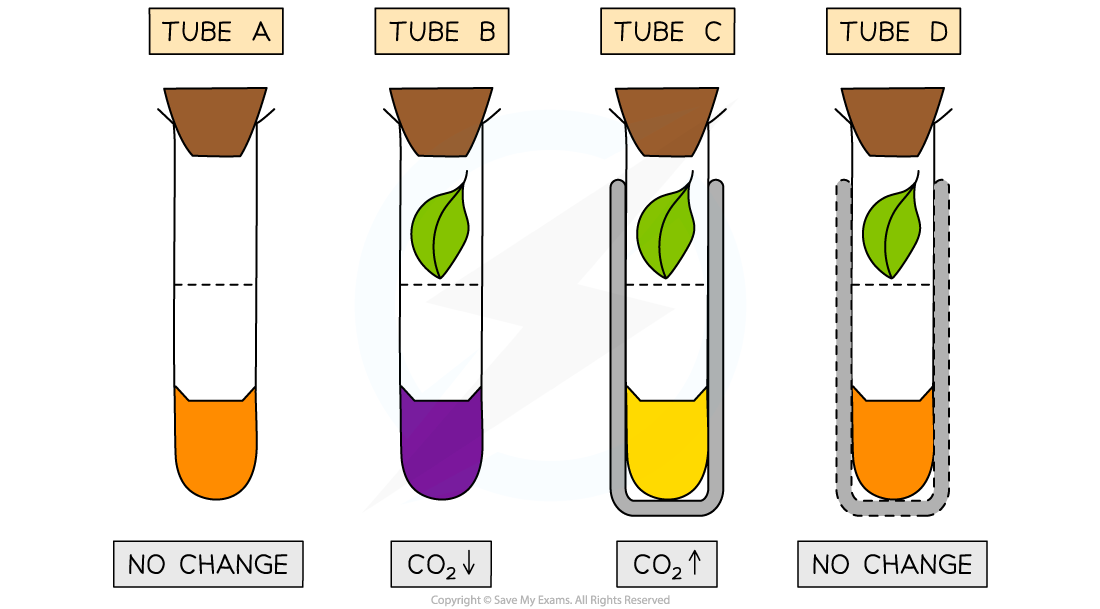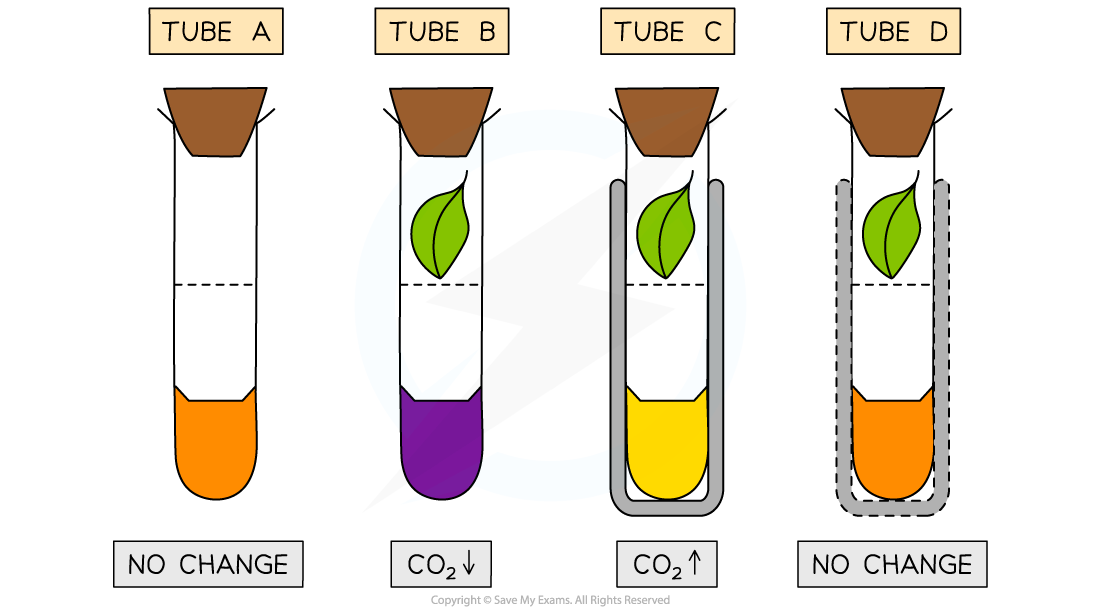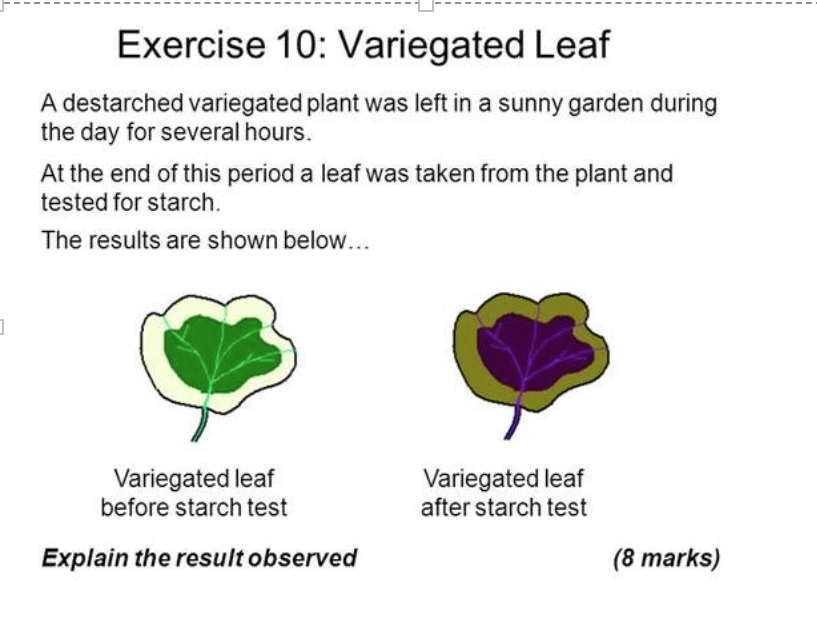Biology - Plant Nutrition
1/30
Earn XP
Description and Tags
Name | Mastery | Learn | Test | Matching | Spaced |
|---|
No study sessions yet.
31 Terms
word equation for photosynthesis
Carbon Dioxide + Water --(Sunlight + Chlorophyll)> Glucose + Oxygen
chemical equation for photosynthesis
6CO2 + 6H2O ------> C6H12O6 + 6O2
why is sunlight needed for photosynthesis
Provides the light energy which is converted into chemical energy in the bonds in glucose.
why is carbon dioxide needed for photosynthesis
Absorbed from the air and enters the leaf via the stomata
why is water needed for photosynthesis
Absorbed from the soil via the root hairs
why is glucose needed for photosynthesis
A simple sugar (monosaccharide) and a carbohydrate. It is used in respiration to release energy.
It is used to make cellulose cell walls.
Stored as starch in starch grains found in chloroplasts. Starch is insoluble so can be stored in cells without affecting water movement in and out of cells by osmosis. Some plants such as rice and potato store large amounts of starch in parts such as seeds and tubers which are used as a food source.
Some glucose is converted to sucrose (a double sugar (disaccharide) made from glucose joined to another sugar fructose), this is soluble and is the form in which sugar is transported around the plant.
Plants can convert glucose to Fructose (monosaccharide) found in fruits.
Glucose can also be converted to other types of molecules e.g. proteins and lipids
why is oxygen needed for photosynthesis
A product of photosynthesis, used in plants for respiration, most is not needed and is given out as a waste product
why is chlorophyll needed for photosynthesis
Molecule that captures energy from sunlight. The green pigment present in chloroplasts. Chloroplasts mainly found in the palisade cells; these cells are found towards the upper side of the leaf.
why is temperature needed for photosynthesis
To provide the right conditions for the enzymes needed for photosynthesis to work. If it is too cold the enzymes become in active and rate of photosynthesis slows down. If too high enzymes are denatured and photosynthesis does not occur.
external adaptations for a leaf (size)
Leaf is long and broad to give a large surface area to absorb light
external adaptations for a leaf (colour)
Leaf is green containing chlorophyll to absorb light
external adaptations for a leaf (veins)
The leaf has a network of veins that carry water and other substances to the leaf and glucose away
external adaptations for a leaf (depth)
The leaf is thin to allow diffusion to occur (gases into and out of the leaf)
external adaptations for a leaf (direction)
The leaf is held to the stem by the petiole, and faces the sun

label the diagram
A/C = upper epidermis
B = cuticle
D = palisade layer
E = spongy layer
F = vein
G = lower epidermis
H/I = guard cells
J = lower epidermis cells
function of the epidermis
Two outer layers of cells (upper and lower epidermis), upper epidermis is a transparent layer of cells that allows as much light as possible to reach palisade cells, the site of photosynthesis. Covered in a thin waxy material called the cuticle, this reduces water loss by evaporation and acts as a barrier preventing entry of disease causing microorganisms e.g. bacteria and fungi.
FULL MARKS
Absorbing light
Photosynthesis
Many chloroplasts
function of the Palisade mesophyll
A tightly packed layer of cylindrical cells below the upper epidermis, where most of photosynthesis takes place. Packed full of many chloroplasts containing chlorophyll which absorbs light.
function of the Spongy mesophyll
Below the palisade layer is a layer of more rounded loosely packed cells with air spaces between them. They contain a few chloroplasts so photosynthesis can take place. They form the main gas exchange surface of the leaf absorbing Carbon-dioxide and releasing oxygen and water vapour. The air spaces allow these gases to diffuse in and out of the mesophyll.
function of the Stomata
The lower epidermis has many pores called stomata, which allow carbon dioxide to diffuse into the leaf and oxygen and water vapour to diffuse out. Each stoma is formed as a gap between two specialised cells called guard cells which can alter their shape to open and close the stoma. Upper epidermis has fewer or no stomata.
function of the phloem
The products of photosynthesis (sugars*) are transported away from the mesophyll cells of the leaf by the phloem to all other parts of the plant. The veins in the leaf contain both the xylem and the phloem tissue, and branch again and again to supply all parts of the leaf.
function of the xylem
Water is absorbed by the roots and passes up the xylem vessels in the stem to the leaves in transpiration stream. In the leaves water leaves the xylem and supplies the mesophyll cells.
define photosynthesis
the production of sugar in green plants

what does tube A mean?
no respiration or photosynthesis so no net movement of CO2

what does tube B mean? (orange→purple)
photosynthesis>respiration. theres a net intake of CO2, the level decreases

what does tube C mean? (orange→yellow)
no photosynthesis due to lack of light. theres a net release of CO2. the level increases as a result of respiration

what does tube D mean?
photosynthesis=respiration, there is no net movement of CO2. the level remains the same.

what does each part mean
green - has chlorophyll
white - has no chlorophyll
blue - has starch
yellow - has no starch

why does the bell jar contain soda lime
to absorb CO2
what do plants need glucose for
As a respiratory substrate
To convert to starch for storage
Glucose (monosaccharide) converted to fructose (found in fruits)
Glucose converted to sucrose (disaccharide), the main sugar transported in phloem
Glucose converted to cellulose (polysaccharide) used to form cell walls
Glucose converted to lipids,
State what lipids are used for in plants:
Storage in seeds, they story energy as oil
Also used for making cell membranes
Glucose is used to make proteins by combining with nitrates – proteins for plant growth
what minerals in plant growth for
Plants need a source of nitrogen to make proteins for growth
Plants need nitrogen and magnesium to make chlorophyll
These elements are dissolved in water in soil as mineral ions. Plants absorb mineral ions through the roots, using active transport because the concentration of ions in soil is lower than in plant cells.
Plants that are nitrogen deficient tend to show stunted growth and yellowing of older leaves
Plants deficient in magnesium have yellow leaves between the veins, particularly in older leaves as magnesium is transported in the plant to new leaves.